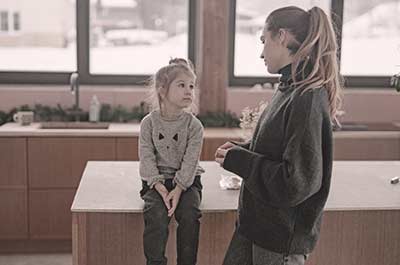Are you looking for a way to help your kids develop a thankful attitude? Teaching them to be grateful for what they have is a great way to start. Here are some tips on how to get started.
Talk about what it means to be thankful.

One of the best ways to teach kids about thankfulness is to talk about it. Explain what it means to be thankful and why it’s important. Share your own experiences of feeling grateful and why they made you happy.
Being thankful is more than just saying “thank you.” It’s about having a grateful attitude and showing appreciation for what you have. Kids often take things for granted, so it’s important to talk to them about being thankful. You can start by teaching them to say “thank you” when someone does something nice for them.
But it’s also important to help them understand why it’s important to be thankful. For example, you can explain that being grateful helps us show appreciation for what we have, and it also makes other people feel good.
Being thankful doesn’t always come naturally. Sometimes we have to stop and think about all the good things in our lives-especially when things are tough. That’s why it’s important to talk to your kids about gratitude. Help them understand that it’s okay to feel sad or angry sometimes, but it’s important to focus on the good things too.
Help them identify what they’re thankful for.
Once you’ve talked about being thankful, help your kids identify things they’re grateful for. This can be done through daily conversations or by brainstorming together.
You can ask your kids questions like, “What are three things you’re thankful for today?” or “Who or what do you always feel grateful for?” Help them develop specific examples and talk about why they’re thankful for those things.
Talk about specific things you’re grateful for, like a warm bed to sleep in at night or a healthy body. Help them understand that there are always things to be thankful for, no matter what might be going on in their lives.
Show them how to say “thank you” in different languages.
When kids learn to say “thank you” in different languages, it opens up a whole new world of possibilities. They can express their gratitude to someone from another culture, learn more about other customs, and even make new friends. And it’s not as difficult as you might think. Just a few simple phrases can go a long way. Here are a few to get you started:
In French, you can say “merci” (pronounced like “mare-see”). In Spanish, “gracias” (pronounced “gra-thee-as”). In German, “Danke” (pronounced like “Dahn-kuh”). There are many other ways to say “thank you” in different languages, but these are just a few of the most common ones. So next time you hear someone speaking a different language, take the opportunity to show them how to say “thank you” on your own. It might just make their day.
Encourage them to express their thankfulness.
After your kids have identified things they’re grateful for, encourage them to express their thankfulness. This can be done in many ways, such as through writing, drawing, or simply talking about it.
One idea is to have them write down one thing they’re thankful for each day. You could also start a gratitude jar where they can write down things they’re thankful for and read them back later.
Another way to encourage expression is to model it yourself. Show your kids how you express thankfulness in your own life. This could be through saying thank you often, writing thank-you notes, or volunteering.
Helping your kids develop a thankful attitude is a great way to teach them about gratitude. It’s also a great way to help them build positive character traits that will last a lifetime.
Make gratitude a part of their daily routine.

Help your kids develop a habit of being thankful by making it a part of their daily routine. You could try starting a gratitude journal where everyone in the family writes down one thing they’re grateful for each day. Or create a gratitude collage where everyone contributes pictures, words, or other items that represent things they’re thankful for.
You could also set aside time each day to talk about what you’re grateful for. This could be at the dinner table, before bed, or even just while you’re walking the dog. The important thing is to make it a regular part of your day so that it becomes second nature.
Gratitude is something we can all benefit from-kids and adults alike. By teaching your kids to be thankful, you’re helping them develop a positive attitude and setting them up for a lifetime of success.
Find ways to give back.
One of the best ways to teach kids about thankfulness is to help them find ways to give back. This could be done through volunteering, donating items, or simply helping others in need.
There are many ways to give back, so find something that works for your family. Whatever you do, make sure it’s something that your kids are interested in and involved with.
Showing your kids how they can make a difference in the lives of others is a great way to teach them the importance of thankfulness. It’s also a great way to help them develop a sense of compassion and empathy.
Helping others is one of the best ways to feel good about ourselves. It’s also a great way to show our kids that we care about them and the world around us.
Encourage kids to help out with household chores.
One way to teach kids about thankfulness is to encourage them to help out with household chores. This can be a great way to show them that we all have to pitch in and do our part. It’s also a great way to teach them responsibility.
There are many ways to get kids involved in household chores. You could assign specific tasks to each child or let them choose which tasks they’d like to do. You could also make it a game or a competition to see who can do the most chores in a week.
Whatever you do, make sure it’s something that your kids are interested in and willing to do. Chores should be seen as a way to help out, not a punishment.
Praise your kids when they express thankfulness or act gratefully.
One of the best ways to encourage kids to be thankful is to praise them when they express thankfulness or act in a grateful manner. This will help them understand that their actions are appreciated and that being thankful is important.
You could give verbal praise, such as saying, “Great job!” or “That was very thoughtful of you.” You could also give physical praise, such as a hug or a high-five. Whatever you do, make sure it’s something that your kids will appreciate.
Encouraging your kids to express thankfulness is a great way to teach them about gratitude. It’s also a great way to help them build positive character traits that will last a lifetime.
Model the behavior you want to see.

One of the best ways to encourage kids to be thankful is to model the behavior you want to see. Show your kids how you express thankfulness in your own life. This could be through saying thank you often, writing thank-you notes, or volunteering.
Helping your kids develop a thankful attitude starts with you. If you model the behavior you want to see, your kids are more likely to follow suit.
When you model the behavior you want to see, you’re not only helping your kids develop a thankful attitude, but you’re also setting a good example for them to follow.
Encourage kids to do something nice for someone else.
One of the best things you can do for your kids is to encourage them to do something nice for someone else without expecting anything in return. This can be a difficult concept for kids to grasp, but it’s an important one. It could be done through acts of kindness, such as giving a compliment or helping someone with a task.
When kids learn to give without expecting anything in return, they learn to appreciate the act of giving itself. They also develop a stronger sense of empathy and compassion for others. As kids grow older, these qualities will help them build strong relationships with others. And who knows? Maybe their acts of kindness will inspire others to do the same.
Conclusion.
Teaching gratitude to kids is a process that takes time, effort, and consistency, but the benefits are worth it! As parents, we want our children to be happy and grateful for what they have in life. By teaching them how to be thankful, we are laying down a foundation of happiness and peace that will stay with them throughout their lives. What strategies do you use to teach your child gratitude?

Meet Brenda Tillman: your go-to expert in Cognitive Behavioral Therapy! Not only is she a seasoned therapist, but she’s also a passionate mom blogger who never misses a beat. Dive deep into her insightful blogs, backed by her extensive coursework in Parenting Skills, Learning, and Education. Brenda’s heartwarming family – a son, two daughters, and their adorable pets – often take center stage in her writings. From parenting hacks and relationship tips to health & fitness nuggets, Brenda has been enlightening her readers for over half a decade. Stick around, and you’re bound to discover gems from a mom who wears many hats with grace!
Reviewed By: Joanna Perez and Marcella Raskin
Edited By: Lenny Terra
Fact Checked By: Gabrielle J. Smith
Photos Taken or Curated By: Matthew Mansour